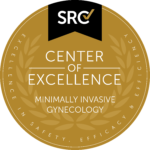Minimally Invasive Gynecologic Surgery
Appointments
Minimally Invasive Gynecologic Surgery (MIGS) Program
Gynecologists at Lahey Hospital & Medical Center are committed to enhancing patient care through the department’s MIGS program.
Lahey offers robotic-assisted surgery for certain gynecologic conditions. The da Vinci Robotic Surgical System allows for a magnified, three-dimensional view of the surgical site, and robotic arms serve as extensions of the surgeon’s hands.
Laparoscopy and hysteroscopy also are available as safe and effective alternatives to more invasive traditional surgery for women with conditions such as endometriosis, fibroids, ovarian cysts, and abnormal bleeding.
Benefits of minimally invasive procedures typically include:
- Faster recovery times
- Less pain
- Minimal scarring
- Lower risk of complications from infection and blood loss
Lahey gynecologists are recognized leaders in performing this innovative surgery, and they actively present on minimally invasive hysterectomies at national and international conferences.
Lahey Hospital & Medical Center offers robotic-assisted surgery for certain gynecologic conditions. The da Vinci Robotic Surgical System allows for a magnified, three-dimensional view of the surgical site, and robotic arms serve as extensions of the surgeon’s hands.
These arms, controlled via the da Vinci system interface, increase the surgeon’s dexterity by filtering out tremors and allowing for 360-degree rotation of surgical tools. The end result is enhanced surgical precision and control that refines and improves the already impressive benefits of laparoscopic surgery.
The da Vinci system also offers better visualization of anatomy, which is critical for surgeons when working around delicate and hard-to-reach structures such as the large pelvic blood vessels.
Robotic procedures available at Lahey include:
- Robotic-assisted laparoscopic hysterectomy
- Robotic-assisted laparoscopic hysterectomy for uterine cancer with lymph node sampling
- Robotic-assisted laparoscopic radical hysterectomy for cervical cancer with lymph node resection
- Robotic myomectomy (to remove uterine fibroids)
Hysteroscopy involves visualizing the inside of the uterus with a camera inserted through the cervix, to help diagnose abnormalities within the lining of the uterus. No abdominal incisions are necessary.
Some of the conditions treated with hysteroscopic surgery include:
- Endometrial ablation (for heavy periods)
- Evaluation of abnormal bleeding
- Removal of certain types of fibroids
Some of the hysteroscopic procedures that Lahey gynecologists perform include:
- Lysis of adhesions (removal of scar tissue)
- Polypectomies (removing fibroids and polyps)
- Sterilization (permanent birth control)
Laparoscopy in gynecology involves examining the reproductive organs with a miniature video camera inserted through a tiny incision in the belly button. When surgeons are not sure what is causing a woman’s pain, a diagnostic laparoscopy can help them view the pelvic organs to find the source of the pain.
Some of the conditions treated laparoscopically include:
- Fibroids
- Removal of benign ovarian cysts
- Treatment of endometriosis
- Sterilization (permanent birth control)
Some of the laparoscopic procedures that Lahey gynecologists perform include:
- Hysterectomies (robotic-assisted, supracervical, total, vaginal)
- Myomectomy (removal of uterine fibroids)
- Ovarian surgery
Minimally Invasive Gynecology Accreditation

The department is accredited as a Center of Excellence in Minimally Invasive Gynecology by the Surgical Review Corporation, which is focused on improving the safety and quality of patient care.

